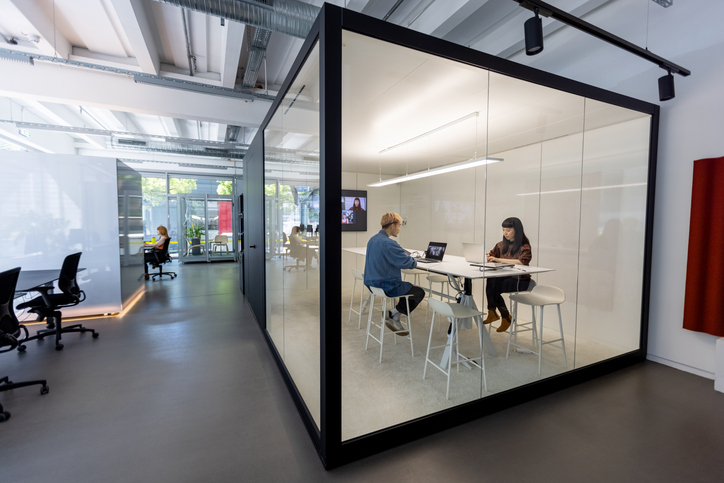Designing Office Space with Acoustics in Mind
Facilities managers who are creating new office spaces or renovating existing ones should work with their employers to design acoustically friendly offices, which would benefit both employees and employers.
Challenges

While many offices embrace an open office plan to encourage collaboration, this presents three main acoustical challenges that affect employees and employers.
1. Productivity
According to the Ceilings & Interior Systems Construction Association (CISCA), employees may have trouble concentrating in open office environments, resulting in a loss of productivity.
Many employers don’t recognize how much office noise can affect productivity. According to Julian Treasure, founder of The Sound Agency, advised businesses worldwide on how to incorporate sound design into their physical spaces and noted in his TED Talk that open office noise can reduce productivity by 66%.
2. Health
According to CISCA, some studies show that poor office acoustics can affect employee health by causing increased stress, high blood pressure, digestive disorders, headaches, hypertension, and ulcers.
Moreover, a study released by the University of Arizona and the University of Kansas found that the ideal volume for office noise is about 50 decibels and that levels significantly above and below can lead to high stress. The Audiovisual and Integrated Experience Association (AVIXA) therefore recommends using white noise machines to provide the right amount of noise in an office environment.
3. Privacy
CISCA also says professionals should consider whether their facilities must meet government regulations, such as the Health Insurance Portability and Accountability Act (HIPAA), especially for medical office buildings, or Social Security Administration (SSA) guidelines, a chief issue in government office facilities.
Additionally, companies should look at their policies to determine what level of privacy and confidentiality is required in their facilities, especially regarding managerial functions.
Solutions
To resolve acoustical problems in the office, here are four practical solutions based on time, personnel, and resources:
1. Different Spaces
Based on the unique needs of the employer and employees, facilities managers should carefully consider how to create one big open office plan, as well as:
- Private offices
- Conference rooms
- Classrooms
If existing spaces are being renovated, consider converting unused private offices into general-use office spaces for employees to use on a first-come, first-served basis, which might be the most beneficial for employers with hybrid work environments.
Don’t forget to create effective sound barriers between all rooms and the hallways they’re adjacent to.
2. Flooring
The International Facility Management Association (IFMA) advocates for the use of specially designed floors that can:
- Limit reverberation time, or the time it takes for sound to drop 60 decibels, according to the University of Oregon, which reports that carpeting can control the high frequencies of speech.
- Reduce disruptive sounds, which are intermittent and can include copy machines, printers, dropped objects, and footsteps, especially in stairwells. To reduce noise, the National Safety Council recommends installing rubberized flooring materials.
- Lower background noise, which can include prolonged outdoor sounds like mowing or traffic. This can be reduced with cushioning beneath the carpet, according to the Carpet and Rug Institute (CRI).
3. Ceiling
Next, consider how you can make the ceiling more acoustically friendly with one or more of the following:
- Use acoustical ceiling tiles with a low sound absorption coefficient rating, as suggested by the American Speech-Language-Hearing Association (ASHA).
- the Whole Building Design Guide (WBDG) recommends ensuring exposed ceiling structures have a low reverberation time.
- According to the AVIXA, areas with a drop ceiling, or an open rather than ducted air return system, should use mineral board tiles.
4. Furnishings and Walls
The IFMA recommends using different types of furnishings that could increase acoustic comfort. Additionally, Inc. suggests using walls and modular panels to solve acoustical issues in your facility.
Facilities professionals should also consider the following:
- Add soft and porous materials like rugs and curtains.
- Have acoustic furniture with specific fabrics and size specifications.
- Install wall flaps (new wall art that can also reduce noise), wings (partition a larger space), and modular panels (create a temporary or permanent soundproof area).
- Provide soft seating options, such as cocoons with high sides, a back, and a roof.
- Provide office furniture like cabinets and lockers.
- Use thick materials like blankets or pillows for break areas.
Conclusion
You can improve the acoustics in your facility by making careful decisions regarding flooring, ceilings, furnishings, and walls, as well as taking into consideration the different space designs of conference rooms, private offices, and classrooms. In doing so, you’ll increase employees’ productivity and remain compliant with government and company privacy and confidentiality regulations.
The post Designing Office Space with Acoustics in Mind appeared first on Facilities Management Advisor.

